STCQC batch 1970 Golden Jubilee

By Rebecca Torres
Manila
November 20, 2020
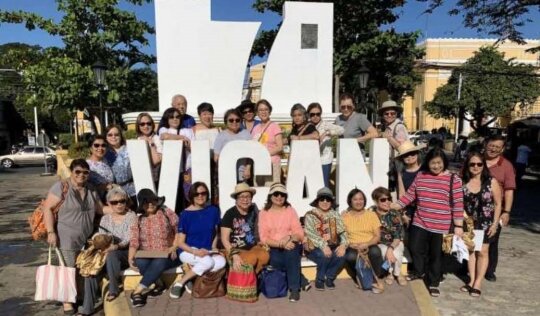 Vigan City, One of 7 Wonder Cities in the World
Vigan City, One of 7 Wonder Cities in the World
Between the eruption of Taal Volcano in Batangas, Philippines in January 2020 and the onset of the Covid-19 pandemic in March in the Philippines, our Batch 1970 had a grand golden jubilee celebration, 50 years from our high school graduation from St. Theresa’s College, Quezon City. One of our golden jubilee events was a four-day out-of-town destination bonding in Vigan and Ilocos, north of the Philippines, at the end of January
Tour of the Heritage City of Vigan
The main attraction of Vigan, a UNESCO Heritage Site and one of the Seven Wonder Cities of the World in 2014, is its old world charm of being one of the best preserved Spanish colonial towns in Asia with centuries-old ancestral homes and cobble stone streets.
Our parada of 17 kalesas (parade of horse-drawn carriages) around Vigan was a unique experience. Our city tour started from Calle Crisologo Heritage Street , with both sides lined with ancestral houses dating back to the Spanish times with handicraft, woodwork, souvenir shops and restaurants at the ground level.
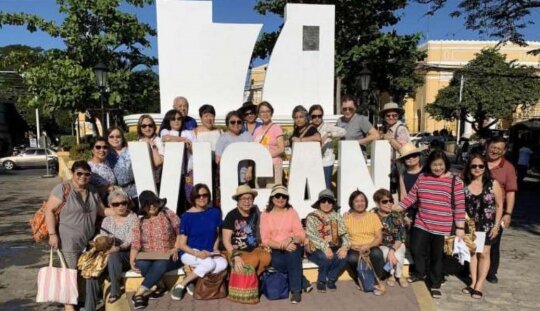 Vigan City, One of 7 Wonder Cities in the World
Vigan City, One of 7 Wonder Cities in the World
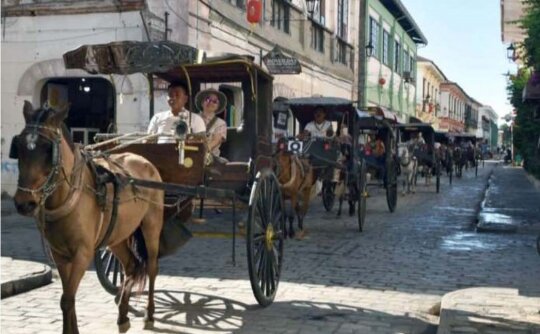 Crisologo Heritage Street, Vigan City - parada of kalesas
Crisologo Heritage Street, Vigan City - parada of kalesas
At the center of town is the high point of our city tour where we appreciated the urban planning of an old Spanish town. We walked around Plaza Salcedo surrounded by the St. Paul’s Metropolitan Cathedral, originally built in 1574, and its separate bell tower; the Kapitolyo (Provincial Capitol) and the Munisipyo (City Hall). Plaza Salcedo is named after Juan de Salcedo, a Spanish Conquistador, who founded “Villa Fernandina de Vigan,” and where a lights and sound spectacle featuring the colorful dancing fountains is shown every evening.
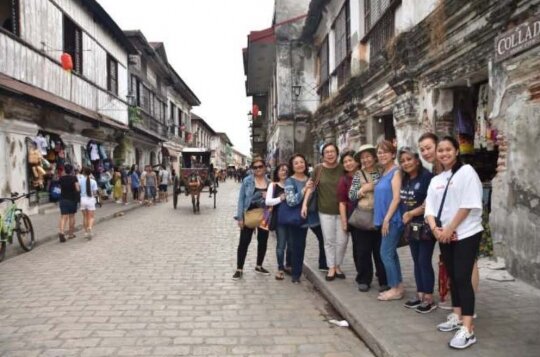 Strolling on Crisologo Heritage Street
Strolling on Crisologo Heritage Street
We next visited Safari Gallery in Baluarte, a nature-themed sanctuary and inter- active gallery of wildlife. Vigan is also famous for its pagburnayan (clay pottery) a century- old art form, where we observed Fidel Antiporda Go, a National Folk Artist as conferred by the National Commission for Culture and the Arts, as he demonstrated old-fashioned burnay making (clay pot making). Abel (handloom textile) weaving is another Vigan traditional craft where weavers transform colorful yarns into woven products like blankets called ules , table runners and hand towels using a wooden handloom.
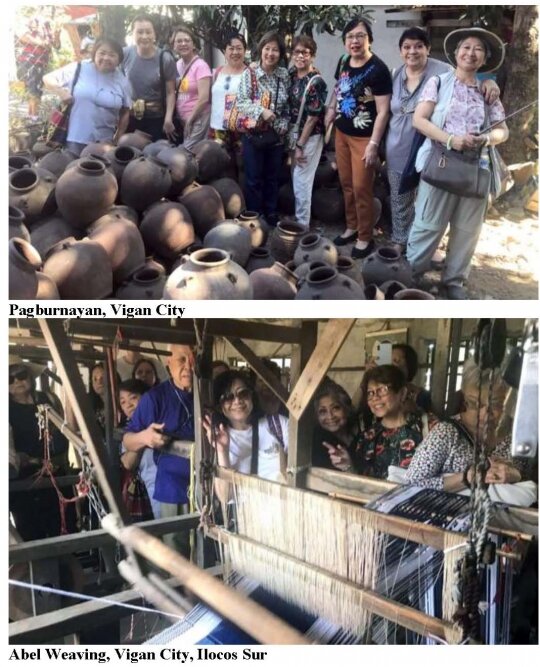
Our city tour will not be complete without visiting the “must-see” century old Syquia Mansion Museum , home of Doña Alicia Syquia Quirino, wife of Philippine President, Elpidio Quirino. It features an azotea, a wide-open balcony, on the second floor and spacious rooms filled with paintings and antique furniture from different parts of the world. A huge replica of Juan Luna’s Spolarium is centrally displayed in the formal reception area.
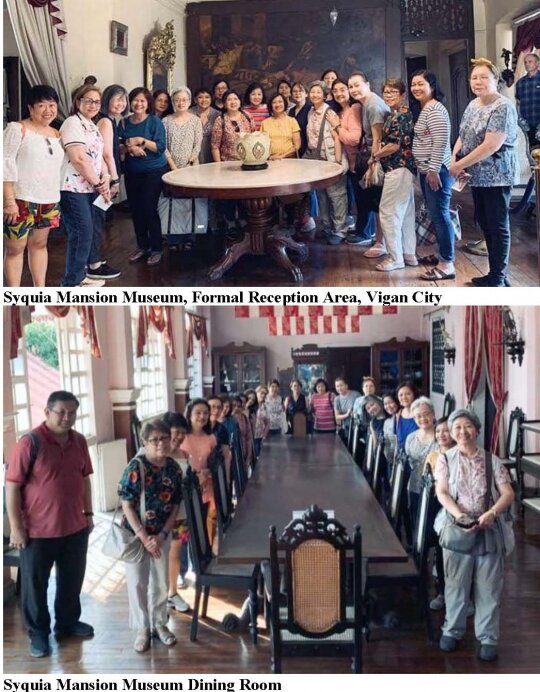
Hotel Luna, built in 1882 and restored into a first-class museum hotel, is another repository of local artworks. We viewed a collection of the finest paintings and artworks of the famous Juan Luna, the Philippines’ National Artists like Fernando Amorsolo and Vicente Manansala, Master Sculptors Napoleon Abueva and Ramon Orlina, and the Master of Contemporary Filipino Art, Bencab. A mural in the outdoor patio depicts the Sta. Maria Church, a UNESCO World Heritage Site, Tirad Pass, Calle Crisologo and St. Paul Cathedral.
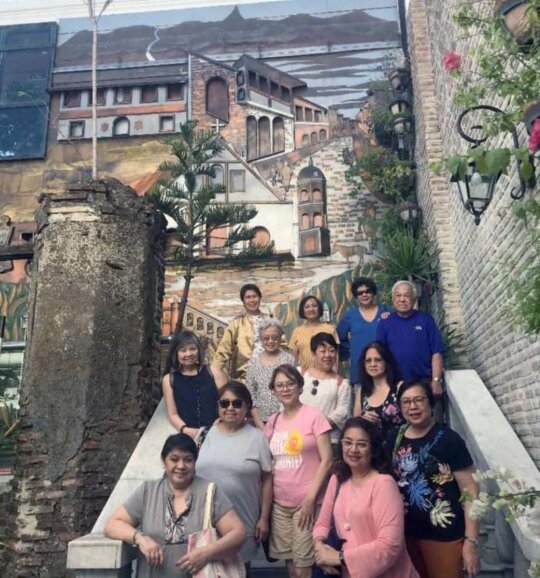 Mural in Hotel Luna, Vigan City
Mural in Hotel Luna, Vigan City
Savoring Ilokano Cuisine
Our food tripping provided a gastronomic experience of Ilokano regional cuisine with ingredients, such as lowland vegetables and viands that are simply prepared and spiced with bagoong (fermented fish) or sukang iloko (cane vinegar).
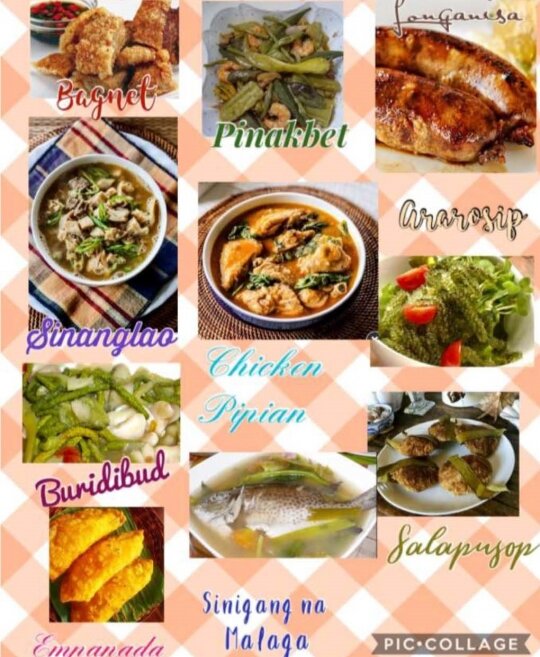 Ilokano Cuisine Food Tripping
Ilokano Cuisine Food Tripping
Our Ilokano breakfast spread showcased the famous Vigan longanisa (garlicky sausage), lomo lomo soup (made of sliced pork tenderloin, liver, kidney and spleen) and poqui poqui (broiled and mashed eggplant sautéed with garlic, tomatoes and onions, and scrambled eggs with bagoong.)
For our first dinner in Vigan, we donned Filipiniana colonial costumes amidst the backdrop of the period furnishings of Arce Mansion , a restored colonial home.
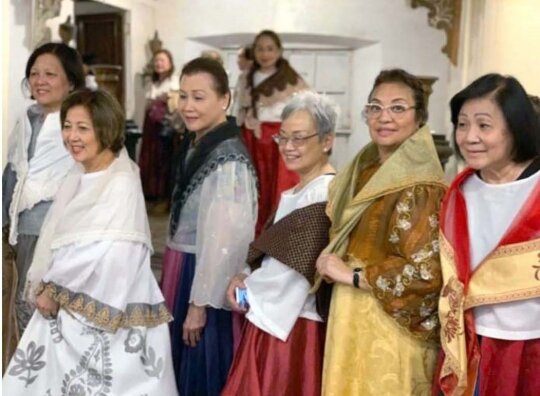 Colonial Filipiniana Costume in Arce Mansion, Vigan City
Colonial Filipiniana Costume in Arce Mansion, Vigan City
We savored the popular Ilokano dishes of bagnet (pork belly deep fried until crispy), served with kamatis (tomatoes), bagoong and lazuna (onions) and buridibud , a dish of mixed vegetables consisting of talong (eggplant), ampalaya (bitter melon), okra (lady fingers) and sitaw (string beans) steamed in bagoong.
In Hotel Veneto de Vigan where we were billeted, we also tasted less popular Ilokano dishes: sinanglao, a beef stew, and igado, made of pork tenderloin and liver, together with inihaw (broiled) malaga (rabbit fish) and ararosip (seaweeds).
A “not to be missed” Vigan street food is Irene’s Vigan empanada, made of annatto colored rice flour dough-filled with green papaya and paired with sukang loko, and okoy, crispy fritters made of small shrimps and malagkit (glutinous) rice batter.
For our farewell dinner in Vigan, Villa Angela Heritage House was a fitting venue in an authentic Spanish-inspired house built in 1873. The comedor (dining room) has a long antique dining table made of narra (Philippine mahogany) which can seat 20 guests. We feasted on sinigang na malaga and sautéed ipon (gobies which is seasonal and only available between November and February; bagnet, pinakbet vegetable dish and chicken and pork pipian, Ilokano porridge with its unique taste due to the pasotes herb.
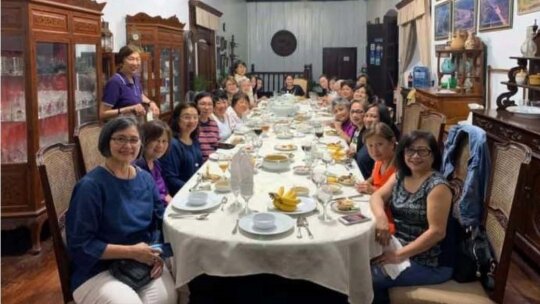 Villa Angela Heritage House Dining Room, Vigan City
Villa Angela Heritage House Dining Room, Vigan City
For dessert after our meals, aside from the popular Royal Vigan bibingka (rice cake) and patupat (cone shaped rice cake) wrapped in banana leaves with sliced sweet mango, our sweet tooth was satisfied with a selection of vintage Ilocano delicacies like the salapusop, a traditional rice cake topped with muscovado (unrefined brown sugar), masapodrida, Filipino shortbread cookies, and the canotillo, sugar wafer tubes with sweetened condol filling.
I locos Norte Day Tour
On our third day, we took an Ilocos Norte day tour. Our first stop was in Paoay’s San Augustine Church , a UNESCO World Heritage Site, which was constructed in 1694 and is famous for its baroque architecture, with enormous 24 massive carved buttresses on the sides and back of the church for support.
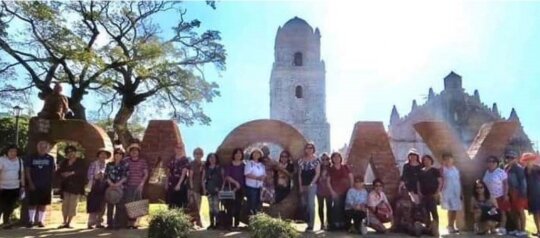 Paoay Church, Ilocos Norte
Paoay Church, Ilocos Norte
Across the Paoay Church is Herencia Restaurant which offers the best tasting Ilokano Pinakbet Pizza, with main ingredients of the typical pinakbet vegetables like eggplant, tomato, string beans and ampalaya, and the Longganisa Pizza with its combination of cheese and garlicky, tangy slices of longganisa.
We also visited the Malacanang of the North in Paoay, a presidential museum housing the memorabilia of President Ferdinand Marcos.
After lunch in Laoag City, the capital of Ilocos Norte, we motored farther north to the town of Burgos to visit the Cape Bojeador Lighthouse , declared the Philippines’ National Cultural Treasure in 2005. First lit in 1892, this watchtower guided many Spanish galleons along Ilocos Norte’s rocky coastline. To this day, it still safely guides ships that enter the Philippine archipelago. Some of us dared to climb up to the viewing gallery of the stone tower (66 meters tall) and were rewarded with the awesome panoramic view of Cape Bojeador and its Ilocos shoreline.
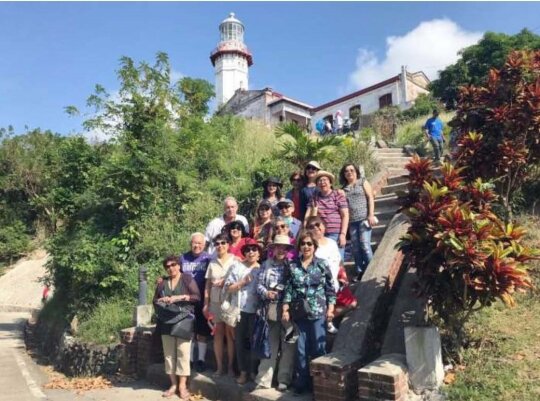 Cape Bojeador Lighthouse, Burgos, Ilocos Norte
Cape Bojeador Lighthouse, Burgos, Ilocos Norte
For our nature trip in Burgos, Ilocos Norte, we trekked down a rugged path. The adventurous ones among us rode a pony to see the Kapurpurawan (white) Rock Formation, a natural landscape of smooth ivory limestone. From Kapurpurawan , one can see a line of windmills comprising the Burgos Wind Farm, the largest in Southeast Asia.
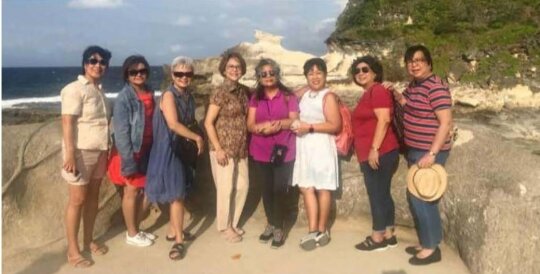 Kapurpurawan Rock Formation, Burgos, Ilocos Norte
Kapurpurawan Rock Formation, Burgos, Ilocos Norte
Return to One s Roots in Santiago
On our return trip to Manila, we stopped over in Santiago, Ilocos Sur, for our classmate, Mel Reyes, to “return to her roots,” a nostalgic visit retracing the footsteps of her mom who spent her early childhood in Santiago.
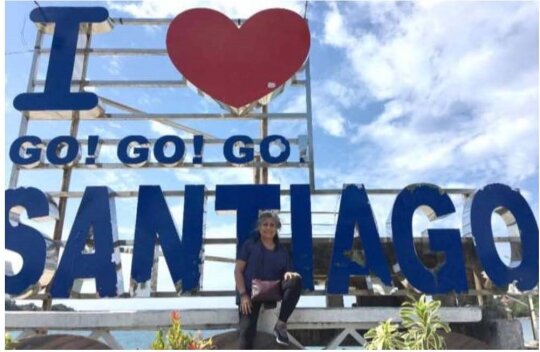 Mel returning to her roots in Santiago
Mel returning to her roots in Santiago
As we entered the town of Santiago, we saw the beautiful vista of the scenic white sands coastline of the Sabangan Cove . We spent mid morning at the Vitalis White Sands overlooking the Vitalis Villas which is dubbed the “Santorini of the North” as it mirrors the original Greek island landscape with its whitewashed cubiform villas with touches of blue.
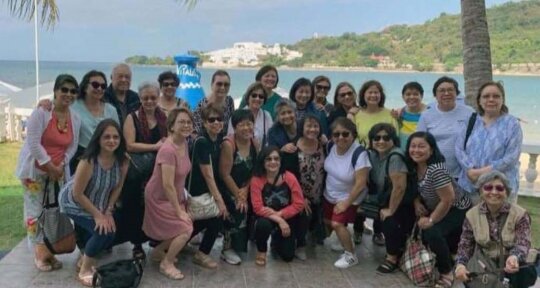 Vitalis White Sands, Santiago, Ilocos Sur
Vitalis White Sands, Santiago, Ilocos Sur
We brought home a part of Ilocos with our purchase of the intricate and colorful handwoven Abel de Santiago , a product of one of the town’s cottage industries as our souvenir.
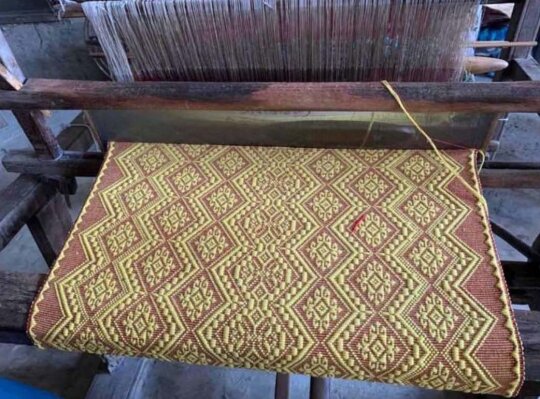 Abel de Santiago, Ilocos Sur
Abel de Santiago, Ilocos Sur
Back to Manila
It was truly a memorable Golden Jubilee celebration with varied experiences in Vigan and Ilocos. Our Vigan (ad)Ventures provided us with different spiritual, gastronomic, cultural and nature tripping memories to remember fondly and cherish until our Emerald Jubilee in 2025.
Vigan (ad)Ventures - A Golden Jubilee, A Celebration

By Rebecca Torres
Manila
November 20, 2020
 Vigan City, One of 7 Wonder Cities in the World
Vigan City, One of 7 Wonder Cities in the World
Between the eruption of Taal Volcano in Batangas, Philippines in January 2020 and the onset of the Covid-19 pandemic in March in the Philippines, our Batch 1970 had a grand golden jubilee celebration, 50 years from our high school graduation from St. Theresa’s College, Quezon City. One of our golden jubilee events was a four-day out-of-town destination bonding in Vigan and Ilocos, north of the Philippines, at the end of January
Tour of the Heritage City of Vigan
The main attraction of Vigan, a UNESCO Heritage Site and one of the Seven Wonder Cities of the World in 2014, is its old world charm of being one of the best preserved Spanish colonial towns in Asia with centuries-old ancestral homes and cobble stone streets.
Our parada of 17 kalesas (parade of horse-drawn carriages) around Vigan was a unique experience. Our city tour started from Calle Crisologo Heritage Street , with both sides lined with ancestral houses dating back to the Spanish times with handicraft, woodwork, souvenir shops and restaurants at the ground level.
 Vigan City, One of 7 Wonder Cities in the World
Vigan City, One of 7 Wonder Cities in the World
 Crisologo Heritage Street, Vigan City - parada of kalesas
Crisologo Heritage Street, Vigan City - parada of kalesas
At the center of town is the high point of our city tour where we appreciated the urban planning of an old Spanish town. We walked around Plaza Salcedo surrounded by the St. Paul’s Metropolitan Cathedral, originally built in 1574, and its separate bell tower; the Kapitolyo (Provincial Capitol) and the Munisipyo (City Hall). Plaza Salcedo is named after Juan de Salcedo, a Spanish Conquistador, who founded “Villa Fernandina de Vigan,” and where a lights and sound spectacle featuring the colorful dancing fountains is shown every evening.
 Strolling on Crisologo Heritage Street
Strolling on Crisologo Heritage Street
We next visited Safari Gallery in Baluarte, a nature-themed sanctuary and inter- active gallery of wildlife. Vigan is also famous for its pagburnayan (clay pottery) a century- old art form, where we observed Fidel Antiporda Go, a National Folk Artist as conferred by the National Commission for Culture and the Arts, as he demonstrated old-fashioned burnay making (clay pot making). Abel (handloom textile) weaving is another Vigan traditional craft where weavers transform colorful yarns into woven products like blankets called ules , table runners and hand towels using a wooden handloom.

Our city tour will not be complete without visiting the “must-see” century old Syquia Mansion Museum , home of Doña Alicia Syquia Quirino, wife of Philippine President, Elpidio Quirino. It features an azotea, a wide-open balcony, on the second floor and spacious rooms filled with paintings and antique furniture from different parts of the world. A huge replica of Juan Luna’s Spolarium is centrally displayed in the formal reception area.

Hotel Luna, built in 1882 and restored into a first-class museum hotel, is another repository of local artworks. We viewed a collection of the finest paintings and artworks of the famous Juan Luna, the Philippines’ National Artists like Fernando Amorsolo and Vicente Manansala, Master Sculptors Napoleon Abueva and Ramon Orlina, and the Master of Contemporary Filipino Art, Bencab. A mural in the outdoor patio depicts the Sta. Maria Church, a UNESCO World Heritage Site, Tirad Pass, Calle Crisologo and St. Paul Cathedral.
 Mural in Hotel Luna, Vigan City
Mural in Hotel Luna, Vigan City
Savoring Ilokano Cuisine
Our food tripping provided a gastronomic experience of Ilokano regional cuisine with ingredients, such as lowland vegetables and viands that are simply prepared and spiced with bagoong (fermented fish) or sukang iloko (cane vinegar).
 Ilokano Cuisine Food Tripping
Ilokano Cuisine Food Tripping
Our Ilokano breakfast spread showcased the famous Vigan longanisa (garlicky sausage), lomo lomo soup (made of sliced pork tenderloin, liver, kidney and spleen) and poqui poqui (broiled and mashed eggplant sautéed with garlic, tomatoes and onions, and scrambled eggs with bagoong.)
For our first dinner in Vigan, we donned Filipiniana colonial costumes amidst the backdrop of the period furnishings of Arce Mansion , a restored colonial home.
 Colonial Filipiniana Costume in Arce Mansion, Vigan City
Colonial Filipiniana Costume in Arce Mansion, Vigan City
We savored the popular Ilokano dishes of bagnet (pork belly deep fried until crispy), served with kamatis (tomatoes), bagoong and lazuna (onions) and buridibud , a dish of mixed vegetables consisting of talong (eggplant), ampalaya (bitter melon), okra (lady fingers) and sitaw (string beans) steamed in bagoong.
In Hotel Veneto de Vigan where we were billeted, we also tasted less popular Ilokano dishes: sinanglao, a beef stew, and igado, made of pork tenderloin and liver, together with inihaw (broiled) malaga (rabbit fish) and ararosip (seaweeds).
A “not to be missed” Vigan street food is Irene’s Vigan empanada, made of annatto colored rice flour dough-filled with green papaya and paired with sukang loko, and okoy, crispy fritters made of small shrimps and malagkit (glutinous) rice batter.
For our farewell dinner in Vigan, Villa Angela Heritage House was a fitting venue in an authentic Spanish-inspired house built in 1873. The comedor (dining room) has a long antique dining table made of narra (Philippine mahogany) which can seat 20 guests. We feasted on sinigang na malaga and sautéed ipon (gobies which is seasonal and only available between November and February; bagnet, pinakbet vegetable dish and chicken and pork pipian, Ilokano porridge with its unique taste due to the pasotes herb.
 Villa Angela Heritage House Dining Room, Vigan City
Villa Angela Heritage House Dining Room, Vigan City
For dessert after our meals, aside from the popular Royal Vigan bibingka (rice cake) and patupat (cone shaped rice cake) wrapped in banana leaves with sliced sweet mango, our sweet tooth was satisfied with a selection of vintage Ilocano delicacies like the salapusop, a traditional rice cake topped with muscovado (unrefined brown sugar), masapodrida, Filipino shortbread cookies, and the canotillo, sugar wafer tubes with sweetened condol filling.
I locos Norte Day Tour
On our third day, we took an Ilocos Norte day tour. Our first stop was in Paoay’s San Augustine Church , a UNESCO World Heritage Site, which was constructed in 1694 and is famous for its baroque architecture, with enormous 24 massive carved buttresses on the sides and back of the church for support.
 Paoay Church, Ilocos Norte
Paoay Church, Ilocos Norte
Across the Paoay Church is Herencia Restaurant which offers the best tasting Ilokano Pinakbet Pizza, with main ingredients of the typical pinakbet vegetables like eggplant, tomato, string beans and ampalaya, and the Longganisa Pizza with its combination of cheese and garlicky, tangy slices of longganisa.
We also visited the Malacanang of the North in Paoay, a presidential museum housing the memorabilia of President Ferdinand Marcos.
After lunch in Laoag City, the capital of Ilocos Norte, we motored farther north to the town of Burgos to visit the Cape Bojeador Lighthouse , declared the Philippines’ National Cultural Treasure in 2005. First lit in 1892, this watchtower guided many Spanish galleons along Ilocos Norte’s rocky coastline. To this day, it still safely guides ships that enter the Philippine archipelago. Some of us dared to climb up to the viewing gallery of the stone tower (66 meters tall) and were rewarded with the awesome panoramic view of Cape Bojeador and its Ilocos shoreline.
 Cape Bojeador Lighthouse, Burgos, Ilocos Norte
Cape Bojeador Lighthouse, Burgos, Ilocos Norte
For our nature trip in Burgos, Ilocos Norte, we trekked down a rugged path. The adventurous ones among us rode a pony to see the Kapurpurawan (white) Rock Formation, a natural landscape of smooth ivory limestone. From Kapurpurawan , one can see a line of windmills comprising the Burgos Wind Farm, the largest in Southeast Asia.
 Kapurpurawan Rock Formation, Burgos, Ilocos Norte
Kapurpurawan Rock Formation, Burgos, Ilocos Norte
Return to One s Roots in Santiago
On our return trip to Manila, we stopped over in Santiago, Ilocos Sur, for our classmate, Mel Reyes, to “return to her roots,” a nostalgic visit retracing the footsteps of her mom who spent her early childhood in Santiago.
 Mel returning to her roots in Santiago
Mel returning to her roots in Santiago
As we entered the town of Santiago, we saw the beautiful vista of the scenic white sands coastline of the Sabangan Cove . We spent mid morning at the Vitalis White Sands overlooking the Vitalis Villas which is dubbed the “Santorini of the North” as it mirrors the original Greek island landscape with its whitewashed cubiform villas with touches of blue.
 Vitalis White Sands, Santiago, Ilocos Sur
Vitalis White Sands, Santiago, Ilocos Sur
We brought home a part of Ilocos with our purchase of the intricate and colorful handwoven Abel de Santiago , a product of one of the town’s cottage industries as our souvenir.
 Abel de Santiago, Ilocos Sur
Abel de Santiago, Ilocos Sur
Back to Manila
It was truly a memorable Golden Jubilee celebration with varied experiences in Vigan and Ilocos. Our Vigan (ad)Ventures provided us with different spiritual, gastronomic, cultural and nature tripping memories to remember fondly and cherish until our Emerald Jubilee in 2025.
